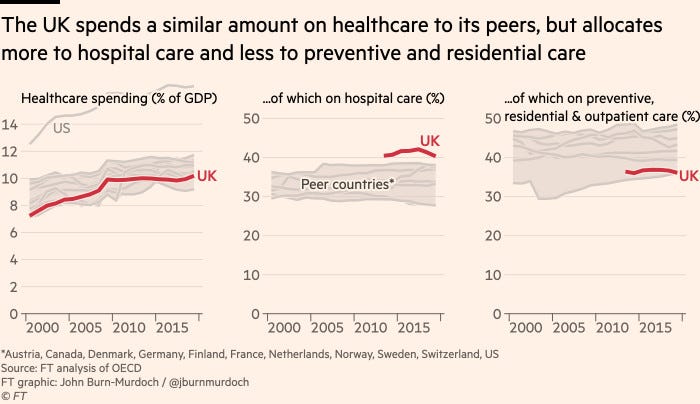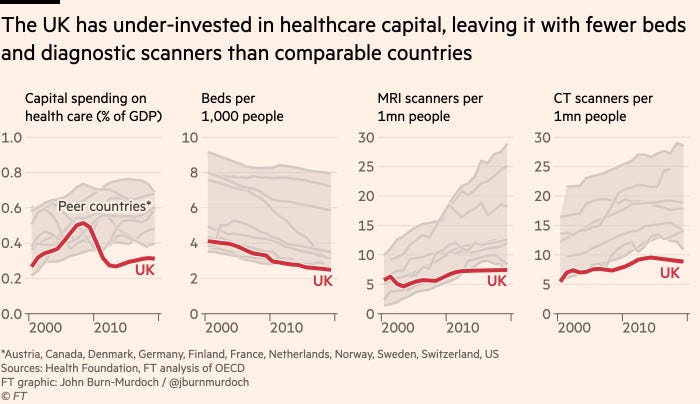The UK allocates more of its healthcare spending to hospital services than any of its peers, and less to preventive medicine, residential and outpatient care, according to OECD data.
Financial Times
john.burn-murdoch
June 2, 2022
Key messages
by Joaquim Cardoso MSc
The Health Revolution
Multidisciplinary Institute, for Better Health for All
June 3, 2022


- Much like any chronic illness, the NHS’s afflictions will not be cured with a sticking plaster.
- The road to recovery is paved with long-term investment to upgrade the physical capacity of the system, and to gradually shift the balance from treatment in hospitals to primary and preventive medicine.

How to fix Britain’s chronically ill healthcare system
Financial Times
john.burn-murdoch
June 2, 2022
In April this year, 24,000 people were left waiting over 12 hours in England’s emergency departments, the highest this figure has ever been.
That same month, roughly 30,000 people who suffered a stroke or sudden chest-pain were kept waiting two hours or more for an ambulance (the target is 40 minutes).
These figures might suggest that England’s hospitals are suffering an acute crisis in their own health, one which requires an urgent infusion of money and staff. But that would be a misdiagnosis.
These figures might suggest England’s hospitals are suffering an acute crisis in their own health, one which requires an urgent infusion of money and staff. But that would be a misdiagnosis.
While the pandemic has undoubtedly created a shock in the UK’s publicly funded health system, the NHS’s underlying issues are chronic.
Waiting lists for elective treatment have been lengthening for 10 years, and the target of keeping 95 per cent of A&E waits under 4 hours missed for just as long. (These figures from NHS England are broadly replicated in Scotland, Wales and Northern Ireland: health service management is devolved.)
It would be easy to blame underfunding, but in 2019 the UK spent just over 10 per cent of GDP on healthcare, placing it among other wealthy western European countries.
The trend over the past two decades has also aligned with comparable nations, according to the OECD.
The next obvious explanation is staffing shortages.
After two years which have shone a light on the heroic work done by hospital staff, it seems logical that problems in hospitals should be solved by increasing the number of doctors on wards. But here, again, the picture is nuanced.
While the number of fully qualified permanent GPs in England has fallen by 8 per cent since 2009, that of hospital doctors has grown by a third, outpacing the growth of the elderly population that accounts for an outsized portion of hospital demand.
Nurse numbers continue to grow despite more departures this year.
The result is that the UK allocates more of its healthcare spending to hospital services than any of its peers, and less to preventive medicine, residential and outpatient care, according to OECD data.
The result is that the UK allocates more of its healthcare spending to hospital services than any of its peers, and less to preventive medicine, residential and outpatient care, according to OECD data.
In other words, ever growing resources are being used to treat ever more sick people, but ever fewer are being used to prevent them from getting sick in the first place.

This is highlighted by the UK ranking among the highest for rates of hospital admission in the OECD for asthma and chronic obstructive pulmonary disease — both of which are considered largely treatable within primary care — and by public satisfaction with GPs plummeting from 68 to 38 per cent in 2021.
This is highlighted by the UK ranking among the highest for rates of hospital admission in the OECD for asthma and chronic obstructive pulmonary disease — both of which are considered largely treatable within primary care —
and by public satisfaction with GPs plummeting from 68 to 38 per cent in 2021.
In the longer term, the focus should be on capital and capacity — beds, diagnostic equipment and IT.
This is the biggest yet often least-discussed bottleneck hampering a patient’s flow through the system.
If the size of the UK’s healthcare workforce leaves room for improvement, then its record on capital investment is truly worst-in-class.
If the size of the UK’s healthcare workforce leaves room for improvement, then its record on capital investment is truly worst-in-class.
For a full decade, the UK has invested far less in capital infrastructure in healthcare than any other major developed nation, according to analysis by the Health Foundation, resulting in fewer beds and diagnostic scanners than comparable countries.
For a full decade, the UK has invested far less in capital infrastructure in healthcare than any other major developed nation, according to analysis by the Health Foundation, resulting in fewer beds and diagnostic scanners than comparable countries.

This picture fits with a report by Monitor, the now-defunct health service regulator.
It recorded that while A&E waiting times were not affected by increased staffing levels in the emergency department, they were highly sensitive to bed shortages in the rest of the hospital.
These shortages in turn related to the delayed discharges of elderly patients, and the steady increase in bed demand.
while A&E waiting times were not affected by increased staffing levels in the emergency department, they were highly sensitive to bed shortages in the rest of the hospital.
These shortages in turn related to the delayed discharges of elderly patients, and the steady increase in bed demand.
None of these headwinds will subside naturally.
The huge pandemic-induced backlog means hospitals are now being asked to get through substantially more elective operations than in 2019.
The number of people aged 85 and over in England will grow another 25 per cent by the end of this decade. Both factors will increase pressure on beds.
The huge pandemic-induced backlog means hospitals are now being asked to get through substantially more elective operations than in 2019.
The number of people aged 85 and over in England will grow another 25 per cent by the end of this decade. Both factors will increase pressure on beds.
Much like any chronic illness, the NHS’s afflictions will not be cured with a sticking plaster.
The road to recovery is paved with long-term investment to upgrade the physical capacity of the system, and to gradually shift the balance from treatment in hospitals to primary and preventive medicine.
Much like any chronic illness, the NHS’s afflictions will not be cured with a sticking plaster.
The road to recovery is paved with long-term investment to upgrade the physical capacity of the system, and to gradually shift the balance from treatment in hospitals to primary and preventive medicine.
Originally published at https://www.ft.com on June 3, 2022.












